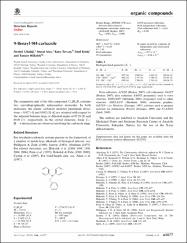| dc.contributor.author | Uludağ, Nesimi | |
| dc.contributor.author | Ateş, Murat | |
| dc.contributor.author | Tercan, Barış | |
| dc.contributor.author | Ermiş, Emel | |
| dc.contributor.author | Hökelek, Tuncer | |
| dc.date.accessioned | 2019-10-20T09:13:18Z | |
| dc.date.available | 2019-10-20T09:13:18Z | |
| dc.date.issued | 2010 | |
| dc.identifier.issn | 1600-5368 | |
| dc.identifier.uri | https://dx.doi.org/10.1107/S1600536810012444 | |
| dc.identifier.uri | https://hdl.handle.net/11421/16811 | |
| dc.description | WOS: 000277323800001 | en_US |
| dc.description | PubMed ID: 21579131 | en_US |
| dc.description.abstract | The asymmetric unit of the title compound, C(19)H(15)N, contains two crystallographically independent molecules. In both molecules, the planar carbazole moieties [maximum deviations = 0.037 (4) and 0.042 (3) angstrom] are oriented with respect to the adjacent benzene rings, at dihedral angles of 85.29 (8) and 89.89 (7)degrees, respectively. In the crystal structure, weak C-H center dot center dot center dot pi interactions are observed involving the carbazole rings. | en_US |
| dc.description.sponsorship | Anadolu University and the Medicinal Plants | en_US |
| dc.description.sponsorship | The authors are indebted to Anadolu University and the Medicinal Plants and Medicine Research Centre of Anadolu University, Eskisehir, Turkey, for the use of the X-ray diffractometer. | en_US |
| dc.language.iso | eng | en_US |
| dc.publisher | Wiley-Blackwell | en_US |
| dc.relation.isversionof | 10.1107/S1600536810012444 | en_US |
| dc.rights | info:eu-repo/semantics/openAccess | en_US |
| dc.title | 9-Benzyl-9H-carbazole | en_US |
| dc.type | article | en_US |
| dc.relation.journal | Acta Crystallographica Section E-Structure Reports Online | en_US |
| dc.contributor.department | Anadolu Üniversitesi, Fen Fakültesi, Fizik Bölümü | en_US |
| dc.identifier.volume | 66 | en_US |
| dc.identifier.startpage | O1077 | en_US |
| dc.identifier.endpage | U94 | en_US |
| dc.relation.publicationcategory | Makale - Uluslararası Hakemli Dergi - Kurum Öğretim Elemanı | en_US |
| dc.contributor.institutionauthor | Ermiş, Emel | |


















